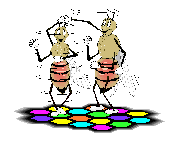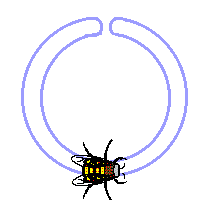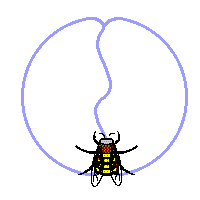
Bee Dances
Bees have devised a very effective method of communicating information about sources of food using a ROUND DANCE and a WAGGLE DANCE (or figure of eight). The dances do not appear to indicate the height of the food above ground level and in most cases this is not important since to a bee the source will be obvious.
ROUND DANCE

This is used when the source of food (nectar or pollen) is less than 100 metres away. The bee dancing goes in a circle on the comb first one way, she turns round and then the other way round the circle. Food is passed from the dancing bee to those watching and following giving information about it's taste and smell. The round dance does not appear to tell the bees in which direction to go to the food source just that the food "is close to the hive and tastes and smells like this".
WAGGLE DANCE

For food supplies more than 100 metres the waggle dance, or figure of eight dance is used. This communicates distance, direction and quality of the food source. There is a straight run between the top and bottom of the figure eight and the angle of this straight run to the vertical on the comb indicates direction relative to the sun's position. The bee uses the force of gravity (vertically downwards) as the position of the sun and if say the food is 30� to the left of the sun the bee will dance 30� to the left of the vertical on the frame on the straight run. Whilst the bee is indicating direction, the length of the straight run and the number of circuits completed per unit time give the distance to the forage source. During the straight run the bee waggles her body from side to side to indicate the quality of the food source. The more waggles, the higher is the quality of the food source in terms of sugar content.
The waggle dance gives direction, distance and quality of the food source and by tasting the food the bee receiving the information knows what to look for
 Download Membership form
Download Membership form